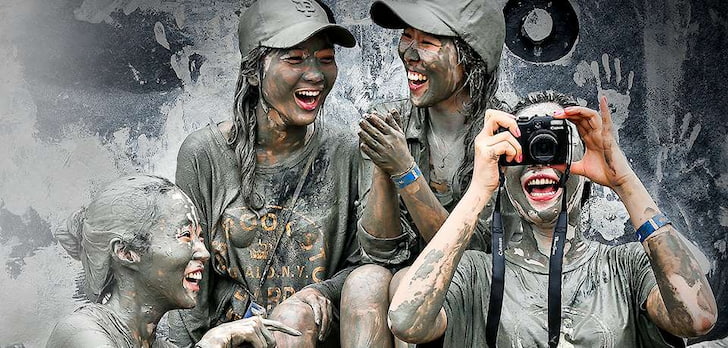The city of Boryeong is situated in South Chungcheong Province and lies on the coast of the Yellow Sea. It has several famous beaches, particularly Daecheon Beach located about 3 km from the city proper. The city also has mud flats with high-quality ocean mud that is believed to have cosmetic purposes. Boryeong mud is rich in naturally occurring minerals (aluminum, calcium, germanium, iron, magnesium, potassium, silicon) that help to detox the skin, stimulate microcirculation and skin renewal, and inhibit the growth of pathogenic bacteria.
In the 1990s, the economy of Boryeong was at risk due to the closure of the nearby coal mine. Park Sang-don, the then-mayor of Boryeong, came up with the idea of producing skincare products with sea mud to diversify local economy and give it a boost. Eight types of mud-based skincare products were developed and released in 1996 and 1997, but the sales were not particularly high due to little awareness.
To help promote mud cosmetics and attract tourists, the city organized the inaugural Boryeong Mud Festival in 1998. The event was the brainchild of Jung Kang-hwan, a professor at Pai Chai University, who was tasked by the Boyeong Culture and Tourism Department with finding ways to transform the existing Manse Boryeong cultural festival from a local resident-oriented event into a tourist attraction that will help promote local products.
The inaugural Boryeong Mud Festival was held at Daecheon Beach from July 16 to 19, 1998 and was a huge success. Since then, it has grown into one of the most popular festivals in South Korea that attracts over 2 million visitors ever year. The Boryeong Mud Festival has been held every summer since its inception except for 2020, when it was canceled due to the COVID-19 pandemic.
In preparation for the festival, tons of mud are excavated from the local mud flats and transported by trucks to Daecheon Beach, which is transformed into the “Mud Experience Land” for the duration of the event. The Boryeong Mud Festival features several major attractions, including a large mud pool, mud slides, mud fights, mud skiing competitions, body painting with colored mud, a large stage with live music, a large firework display, and more.
Of course, mud skincare products still are a part of the festival; visitors can buy them at a small market that runs along the seafront. In addition, local clinics and beauty centers offer massages and other treatments based on the cosmetic and medicinal properties of the Boryeong mud.
The Boryeong Mud Festival runs for about two weeks in late July and early August, but the final weekend is generally regarded as the most fun and attracts the most tourists from all over the country and abroad. The festival is a ticketed event; the tickets can be purchased online or right at the venue.

Photo: mudfestival.or.kr




